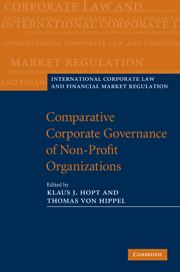Book contents
- Frontmatter
- Contents
- List of contributors
- Preface
- Abbreviations
- PART I Economic findings and theories on nonprofit organizations
- PART II The nonprofit sector: private law, trust law, tax law in selected countries
- PART III The board of nonprofit organizations
- PART IV Good governance of nonprofit organizations: activities and regulatory problems
- 10 Fundraising
- 11 Asset management in nonprofit organizations
- 11.1 Asset management in nonprofit organizations
- 11.2 Legal standards for capital investments by foundations in hedge funds according to German and American law
- 12 Nonprofit organizations and economic activities/enterprises
- PART V Good governance of nonprofit organizations: self-regulation, disclosure and supervision
- Index
- References
11.2 - Legal standards for capital investments by foundations in hedge funds according to German and American law
from 11 - Asset management in nonprofit organizations
Published online by Cambridge University Press: 05 August 2011
- Frontmatter
- Contents
- List of contributors
- Preface
- Abbreviations
- PART I Economic findings and theories on nonprofit organizations
- PART II The nonprofit sector: private law, trust law, tax law in selected countries
- PART III The board of nonprofit organizations
- PART IV Good governance of nonprofit organizations: activities and regulatory problems
- 10 Fundraising
- 11 Asset management in nonprofit organizations
- 11.1 Asset management in nonprofit organizations
- 11.2 Legal standards for capital investments by foundations in hedge funds according to German and American law
- 12 Nonprofit organizations and economic activities/enterprises
- PART V Good governance of nonprofit organizations: self-regulation, disclosure and supervision
- Index
- References
Summary
Introduction
Many charitable organizations such as foundations primarily depend on income from investing their assets in order to promote their goals. In the past, German foundations have generally invested their liquid assets in fixed-interest securities or real estate. At the same time, foundations under German law are fundamentally free to invest their assets in any way. In principle, the same is also true for US private foundations. In contrast to the situation in Germany, it has been recognized in the United States already for some time that not only private foundations, but also other charitable organizations such as religious associations, institutions of higher learning, and hospitals (public charities) are increasingly focusing on alternative investment strategies in order to increase their returns. Given the experiences of many institutional investors with highly volatile stock markets in recent times, and with the constant expectation of strong downward corrections both in the German real estate market and above all in the overinflated American one, the question arises as to what extent hedge funds are of interest to German foundations or American private foundations as an important type of alternative investment technique. This article explains the applicable standards and limitations for investments by these charitable organizations under German and American law and examines the limits that arise for investments in hedge funds.
- Type
- Chapter
- Information
- Comparative Corporate Governance of Non-Profit Organizations , pp. 709 - 739Publisher: Cambridge University PressPrint publication year: 2010



